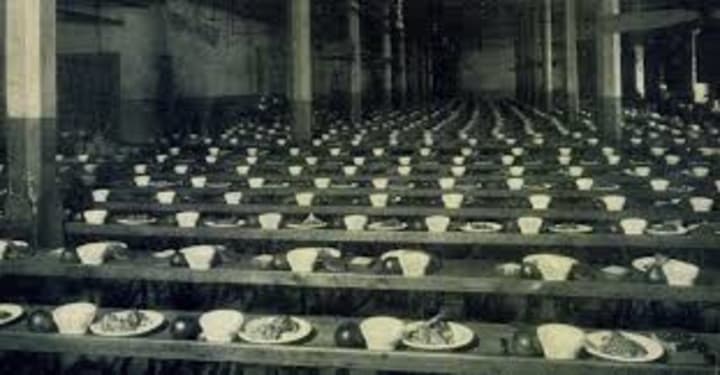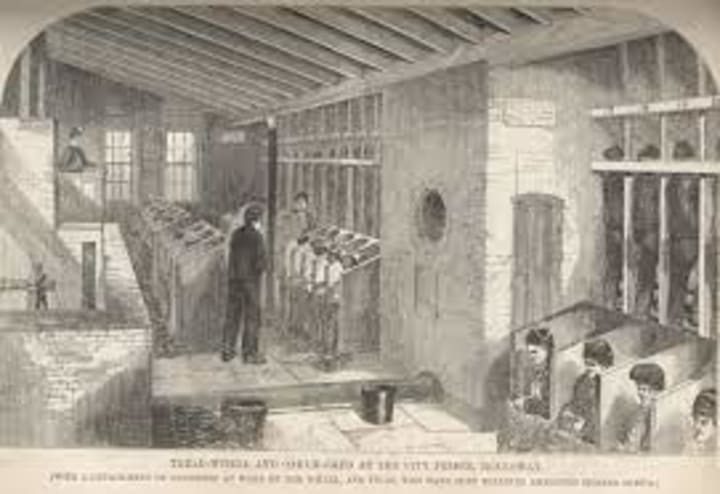Victorian Prisons
"It is not the prisoners who need reformation, it is the prisons" --- Oscar Wilde

The truth about Victorian prisons was that to many (especially those of the poorer classes), life in prison was better than life in their own homes. Many ‘broke the law’ deliberately to go back into prison, for a roof over their heads and ‘decent food’. Even those in the Workhouses did this — because prison was better than the Workhouse!
There were two types of prisons in the Victorian Era. The “Convict” prison where prisoners served three years or more for the more serious offences, and the “Local” prisons where prisoners served up to two years sentences for less serious crimes. The convict prisons had cleaner conditions and there was more humane treatment. The local prisons were not so ‘comfortable’ and the treatment was more severe. This was because convict prisons were under Government control and had to meet certain ‘standards’, whereas local prisons did not and often used 18th Century buildings which were ‘no longer fit for purpose’. The local prisons didn’t come under Government control until 1877.
Once a sentence had been given, the prisoner was sent to a certain prison. On arrival, he or she had a tepid bath, with men having their hair cropped. Women only had their hair cut for hygiene reasons, and only if they agreed to it. Then the prisoner was examined by the medical Officer, height, weight and any physical features were recorded — colour of the eyes and hair, complexion and birthmarks or scars. Also, it was then determined if the prisoner was able to do hard labour or light labour.
The prisoner then had to wear the prison uniform. In local prisons, his or her own clothes were given back once they’d served their sentence. In convict prisons, the prisoner lost his or her own clothes and a new set was given to him or her on release. Of course, if the “Death” sentence had been passed, the prisoner’s own clothes were forfeited to the Crown, as they would not be needed after the sentence. One convict noted: “I took care not to wear too good a suit, so what I stood upright in was all I ‘forfeited to the Crown’.
Once all of this was done, a principal warder would read out the rules and regulations of the prison. “As it took him about three quarters of an hour to read them, by the time he had got to the last rule I had forgotten all the others” recalled another prisoner.
A new ‘life’ was now starting for the prisoner — in prison! Life in prison was like a ‘well-oiled machine’, with a strict timetable, which may have actually helped the prisoner to get through their sentence. The day started at 6am, when the bell rang and each cell door was opened, with scrubbing brushes and cloth being given to each prisoner to clean their cells. The water he or she used to wash in was used to clean the cell. Each prisoner would empty their bucket and get clean water from ‘the sink’, they would then roll up their beds, dress and go to chapel (and have breakfast), when the bell rang again at 7am.
Supervised exercise was staggered, with some having half an hour before breakfast, after chapel, and so on, and ‘exercise’ was always done in silence.

An hour was allowed for dinner, usually at midday, and the prisoners were locked in their cells for this meal. “During the hour a man’s time was his own, and I used to hurry over my dinner so that I might have as long as possible to enjoy my reading”, quoted one prisoner. Then the prisoners ‘worked’ until suppertime (which was around 5pm).
In the evening, prisoners were locked in their cells. Some might receive schooling, (remember that few of the poorer classes could read or write). This was a time of relative ‘liberty’, with those who could read, borrowing books from the prison library.
Sunday was the only day when prisoners did not work, but would go to chapel twice and they would still do their exercise. Also, the day did not start until 7am. For some prisoners, Sundays were long and ‘boring’ days.
The prisoners who were condemned to death because of their crime, lived by different rules whilst in prison (awaiting their ‘release’). He or she was searched to remove anything that was ‘dangerous or inexpedient to leave in his (or her) possession’, and the prisoner was then put into a separate cell, apart from the other prisoners. An officer was on constant watch to prevent suicide.
Juvenile ‘offenders’ were anyone under the age of 14, ‘at the time of the offence committed’. However, there were no special facilities or separate buildings for these young children. At Millbank Prison, an old warden recalled a little boy who was 61/2 years old who was sentenced to transportation. The sad fact is that for many of these ‘little ones’ — prison was better than their own homes, (even where the meals were concerned).
The quality and quantity of food was different in convict and local prisons. Prison ‘diets’ varied according to what the prisoner was doing (hard labour or light labour), and how long he or she was in prison for — and which class they came from. There were 6 main ingredients in prison food => bread, gruel, potatoes, meat, soup and cocoa. It was mainly bread and gruel for breakfast and supper, with meat, potatoes and soup for dinner (alternated between the week). This food was better than that which was given out at the Workhouse!
Discipline was important! In 1865, there were ‘about 1,000 wardens to cope with an average prison population of 18,000’. Strict discipline was needed to keep control. There was a “Mark System” which ‘provided maximum control, allowed minimal indulgences, and yet needed the fewest possible additional punishments’. This seemed to be the best “System” for the wardens, who needed to keep so much control over so many prisoners, (male and female).

It is really something to think about, when the Victorian Prisons had better ‘living conditions and meals’ than many of the poorest classes' homes!
About the Creator
Ruth Elizabeth Stiff
I love all things Earthy and Self-Help
History is one of my favourite subjects and I love to write short fiction
Research is so interesting for me too






Comments
There are no comments for this story
Be the first to respond and start the conversation.